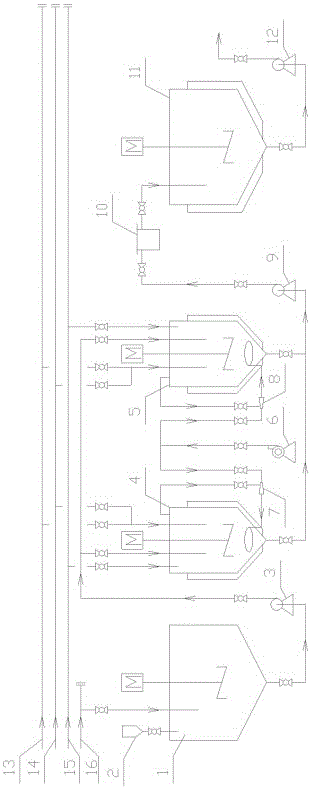Production process of rubber vulcanizing promoter DM
A technology of rubber vulcanization and production process, applied in the direction of organic chemistry, etc., can solve the problems of waste of manpower and material resources, energy consumption of equipment, air pollution, frequent equipment start and stop, etc., to shorten production time, save manpower and material resources, and achieve strong production continuity Effect
- Summary
- Abstract
- Description
- Claims
- Application Information
AI Technical Summary
Problems solved by technology
Method used
Image
Examples
Embodiment 1
[0030] (1) Add 10000L M sodium salt solution (M sodium salt content is 6wt%, resin content is 0.01wt%) into the mixing kettle through the pipeline, start stirring, add 15kg sodium nitrite into the mixing kettle through the hopper, fully Stir to combine well.
[0031] (2) Open the discharge valve of the mixing kettle, start the feeding pump, put the materials in the mixing kettle into the 1# oxidation kettle and the 2# oxidation kettle in sequence, each 5000L, turn on the stirring, turn on the steam to heat to 66°C, if necessary, pass Add cold water or hot water to adjust the temperature, open the fan and related pipeline valves, blow air, and control the air pressure to 0.1Mpa, and open the suction side valve of the injector.
[0032] (3) Use dilute sulfuric acid with a concentration of 30wt%, and control the dripping rate at 300L / h. Stop adding dilute sulfuric acid when the pH of the measured solution is 5, and continue blowing and stirring until the oxidation end point. The ...
Embodiment 2
[0040] (1) Add 10000L M sodium salt solution (M sodium salt content is 4wt%, resin content is 0.01wt%) into the mixing kettle through the pipeline, start stirring, add sodium nitrite and nitrous acid into the mixing kettle through the hopper Sodium is 1wt% of the weight of M sodium salt, fully stirred and mixed evenly.
[0041] (2) Open the discharge valve of the mixing kettle, start the feeding pump, put the materials in the mixing kettle into the 1# oxidation kettle and the 2# oxidation kettle in sequence, each 5000L, turn on the stirring, turn on the steam to heat to 60°C, if necessary, pass Add cold water or hot water to adjust the temperature, open the fan and related pipeline valves, blow air, and control the air pressure to 0.01Mpa, and open the suction side valve of the injector.
[0042] (3) Use dilute sulfuric acid with a concentration of 1wt%, control the acid dripping rate at 50L / h, stop adding dilute sulfuric acid when the pH of the measured solution is 9, continu...
Embodiment 3
[0050] (1) Add 10000L M sodium salt solution (M sodium salt content is 5wt%, resin content is 0.001wt%) into the mixing kettle through the pipeline, start stirring, add sodium nitrite and nitrous acid into the mixing kettle through the hopper Sodium is 2wt% of the weight of M sodium salt, fully stirred and mixed evenly.
[0051] (2) Open the discharge valve of the mixing kettle, start the feeding pump, put the materials in the mixing kettle into the 1# oxidation kettle and 2# oxidation kettle in turn, each 5000L, turn on the stirring, turn on the steam to heat to 62°C, if necessary, pass Add cold water or hot water to adjust the temperature, open the fan and related pipeline valves, blow air, and control the air pressure to 0.05Mpa, and open the suction side valve of the injector.
[0052] (3) Use dilute sulfuric acid with a concentration of 30wt%, control the dripping rate at 200L / h, stop adding dilute sulfuric acid when the pH of the test solution is 6, and continue blowing ...
PUM
 Login to view more
Login to view more Abstract
Description
Claims
Application Information
 Login to view more
Login to view more - R&D Engineer
- R&D Manager
- IP Professional
- Industry Leading Data Capabilities
- Powerful AI technology
- Patent DNA Extraction
Browse by: Latest US Patents, China's latest patents, Technical Efficacy Thesaurus, Application Domain, Technology Topic.
© 2024 PatSnap. All rights reserved.Legal|Privacy policy|Modern Slavery Act Transparency Statement|Sitemap

